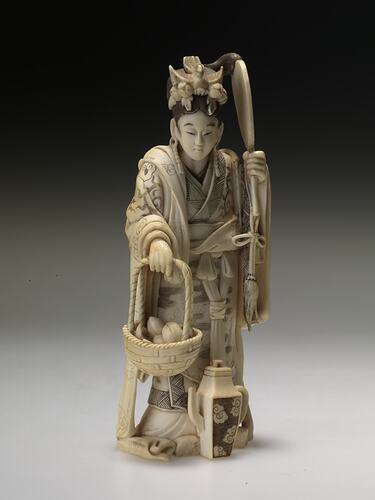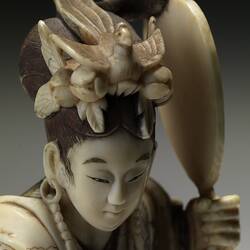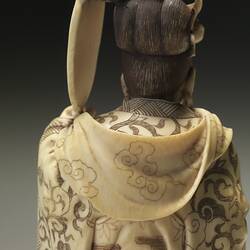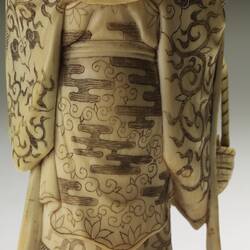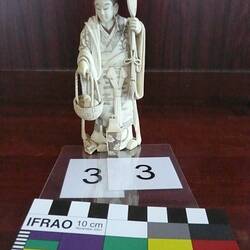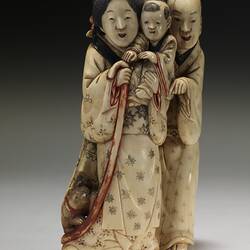Summary
Carved ivory figure (okimono) of the Chinese deity Xi Wangmu, Queen Mother of the West, also known by her Japanese name, Seiobo, manufactured in Japan in the early Meiji period (1868-1880).
An okimono is a small, carved Japanese decorative object created specifically for display, and typically depicts domestic scenes of farmers, fishermen, and children and occasionally, studies of birds, animals and flowers.
Similar to, but larger than netsuke - which served a practical function as a fastener or toggle - okimono were often presented in the tokonoma, an interior alcove or recess in Japanese homes for the display of pictures or decorative art objects. During the Meiji period (1868-1912), many okimono were made for export to the west.
Revered in Taoist belief as the High Priestess Mother of Immortality, Xi Wangmu lives in the Kunlun Mountains in western China, bordering the northern edge of the Tibetan Plateau, south of the Tarim basin in Xinjiang province. She is the guardian of a garden situated high above the clouds in the Kunlun, in which a peach tree grows that ripens only once every 300 years. These peaches produce immortality, which is why Xi Wangmu is always depicted holding or wearing peaches, the symbol of eternal life. In this example, she is holding a basket that is full of peaches.
In the 1st century BC, Xi Wangmu was often paired with Dong Wangmu, the King Father of the East.
Physical Description
Ornate carving of a woman holding a basket of peaches in her right hand, and fan to her head in her left hand. She has an ornate bird decoration in her hair, and a tall, four-sided vessel with a spout at her feet decorated with cloud motifs. The carving is etched in black.
More Information
-
Collection Names
-
Collecting Areas
-
Acquisition Information
Cultural Gifts Donation from Dr Will Twycross, 23 Jan 2009
-
Acknowledgement
Donated through the Australian Government's Cultural Gifts Program
-
Place & Date Made
-
Place & Date Exhibited
Royal Exhibition Building (REB), Nicholson Street, Carlton, Greater Melbourne, Victoria, Australia, 1880-1881
-
Collector
Mr John Twycross, Elsternwick, Greater Melbourne, Victoria, Australia, 1881
-
Classification
Royal exhibition building, International exhibitions, Exhibition heritage
-
Category
-
Discipline
-
Type of item
-
overall dimensions
51 (Width), 40 (Depth), 125 (Height)
-
Keywords
Decorative Arts, Exhibitions: Melbourne International, 1880-1881, Ivory, Japanese Art, Japanese Culture, Royal Exhibition Building, Royal Exhibition Building: History of Events, 1879-1899
